Total Income from Farming Estimates: 2017-2019
Total Income from Farming (TIFF) is the official measure of the profit gained by the agriculture industry in Scotland. It provides a breakdown of the value of farm production, subsidies and costs.
Main findings
Total Income From Farming has been relatively stable in recent years and has marginally changed since 2018.
Income fell slightly in 2019. Whilst outputs from farming rose, they did not increase as much as input costs.
The increase in costs was largely due to the increase in seed, fertiliser and lime costs.
Support payments made to farms, part of the EU’s Common Agricultural Policy, decreased, in real terms, by two per cent in 2019. Support payments accounted for 67 per cent of profit from all farming.
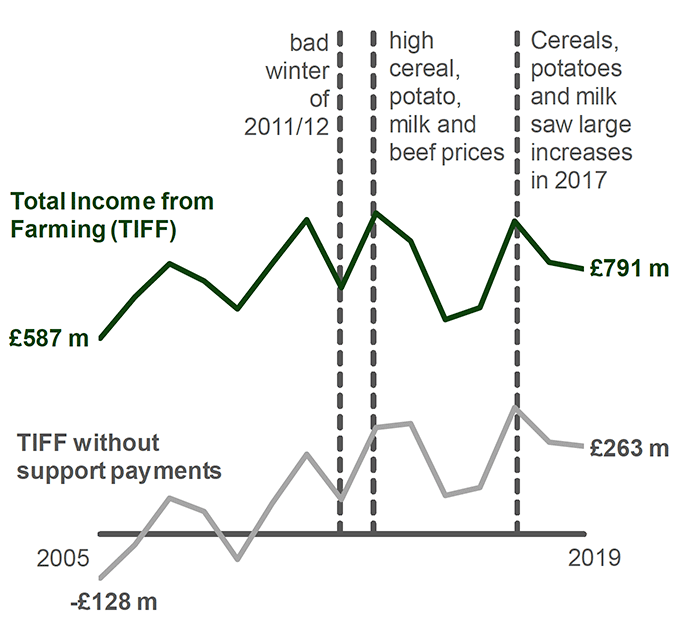
Chart Description
A line chart showing total income from farming with and without support payments from 2005 to 2019. At its lowest point in 2005, TIFF was £587 million with support and -£128 million without. Total income from farming has been generally increasing since 2005. It dropped in 2012 due to a bad winter but had highs in 2013 due to high cereal, potato, milk and beef prices and in 2017 due to increases again for cereals, potatoes and milk. In 2019, TIFF was £791 million with support and £263 million without.
All monetary values shown on this page are adjusted for inflation
Total Income from Farming in 2019: £791million
Total Income from Farming was estimated to have fallen slightly in 2019. The total income is estimated to be £791 million in 2019 which is down three per cent compared to 2018.
Long-term profitability of the sector has generally been increasing, but there has been no consistency in this rise and there are notable periods of decline in 2009 and 2015.
Since 2016 the value of farming output has risen, but this has been offset by associated rising input costs.
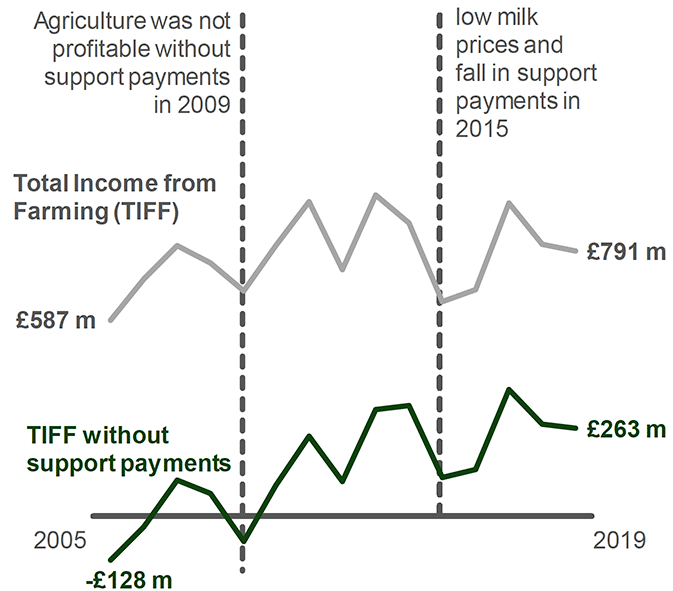
Chart Description
A line chart showing total income from farming with and without support payments from 2005 to 2019. 2009 was the last year that total income from farming was not profitable without support payments. A low was recorded in 2015 due to low milk prices and a fall in support payments.
All monetary values shown on this page are adjusted for inflation
TIFF without support payments: £263 million
Without support payments, the agricultural sector as a whole has been profitable since 2010. However the trend in profitability without support has changed very little over the previous 10 years.
The estimated Gross Value Added (GVA) from agriculture is estimated to be £1.3 billion in 2019. This figure is before support payments, and costs such as labour, rent, taxes and interest are taken into account.
Agriculture is around one per cent of Scotland’s total Gross Domestic Product (GDP).
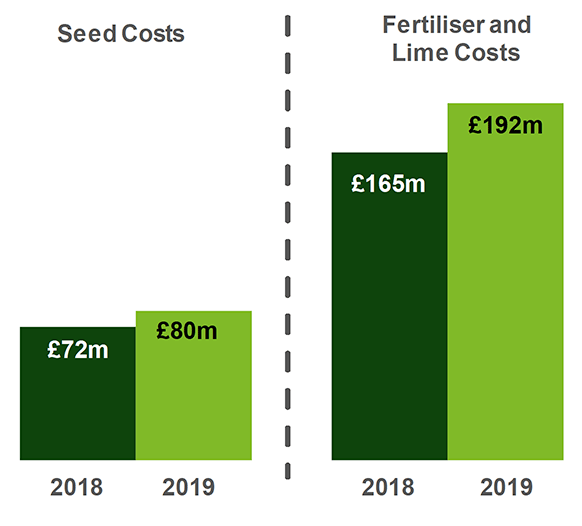
Chart Description
A column chart showing farm costs for seed and for fertiliser and lime in 2018 and 2019. In 2018 seed costs were £72 million and increased to £80 million in 2019. Fertiliser and lime costs in 2018 were £165 million and increased to £192 million in 2019.
2019 data is based on some early estimated data and will be revised next year . These estimates may change but are an early indication for calculating Gross Domestic Product (GDP) for the sector.
Total farming input costs in 2019: £3.08 billion
Total input costs to farming for 2019 rose marginally from the previous year. The figure of £3.08 billion is slightly up compared to the revised 2018 total input costs of £3.04 billion.
The main causes of the increase were fertiliser and lime costs. Seed costs also increased this year but there is some evidence to suggest farm businesses stocked up on these products towards the end of the 2019.
Fertiliser and lime costs were estimated to have increased by £27 million. Seed costs increased by £9 million.
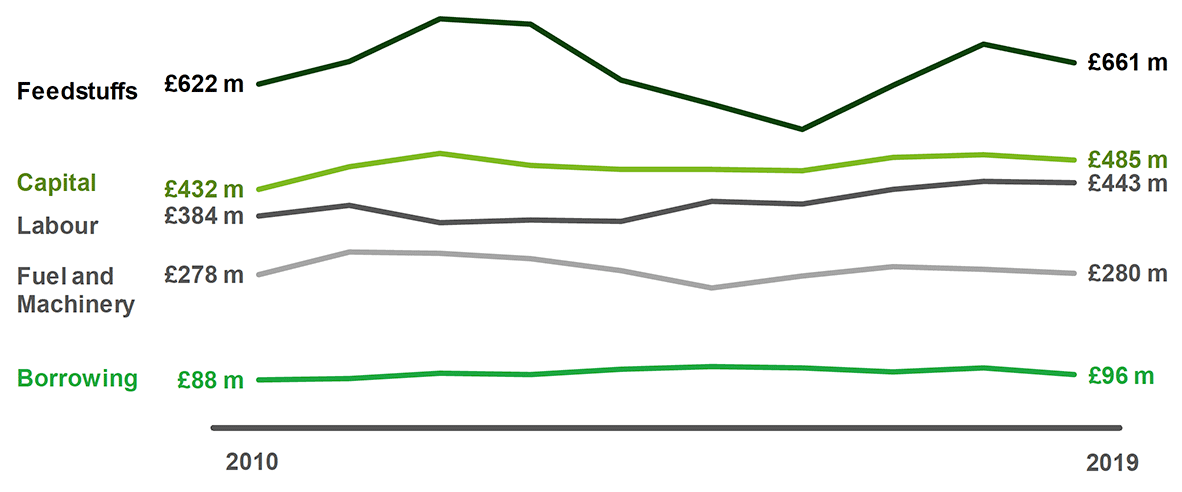
Chart Description
A line chart showing farm costs for different inputs from 2010 to 2019. All costs have increased between 2010 to 2019; feedstuffs from £622 million to £661 million, Capital from £432 million to £485 million, Labour from £384 million to £443 million, Fuel and Machinery from £278 million to £280 million and Borrowing from £88 million to £96 million.
The main costs associated with agricultural production have marginally risen over the last 10 years. The largest rise in costs is associated with labour and the costs associated with borrowing. Feedstuffs continue to be the most variable costs which can be affected by factors such as extreme weather events or global markets.
The cost of borrowing decreased between 2018 and 2019, by £12 million which is mainly because of a decrease in net interest payments. Fuel and machinery costs decreased by £6 million.
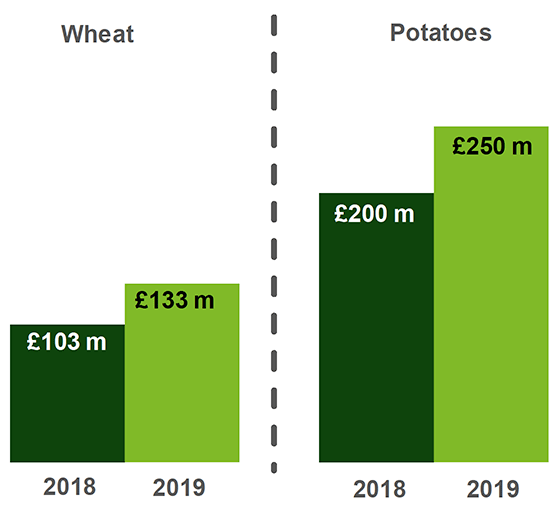
Chart Description
A column chart showing farm costs for seed and for fertiliser and lime in 2018 and 2019. In 2018 seed costs were £72 million and increased to £80 million in 2019. Fertiliser and lime costs in 2018 were £165 million and increased to £192 million in 2019.
2018 data has been revised in this publication. This is due to more data having been collected on economic activity for this year. Therefore 2018 data is called a Second Estimate. Next year the 2018 data will be refined a little more and will be recorded as the ‘Final Estimate’.
Total output from farming in 2019: £3.39 billion
Outputs from farming are estimated to have risen marginally in 2018. Outputs were worth
£3.39 billion compared to an estimated £3.35 billion in 2018.
Increases were seen in the value of output for wheat and potatoes. Wheat output increased by 29 per cent to £133 million and makes up four per cent of total farm output.
Potatoes also increased in value by 25 per cent to £250 million. The value of horticulture which includes other vegetables and fruit production, also increased in 2019 by 13 per cent to £346 million.
The beef sector in 2019 was estimated to be worth £664 million and all livestock combined accounted for a third of all agricultural output, the largest sector in Scotland.
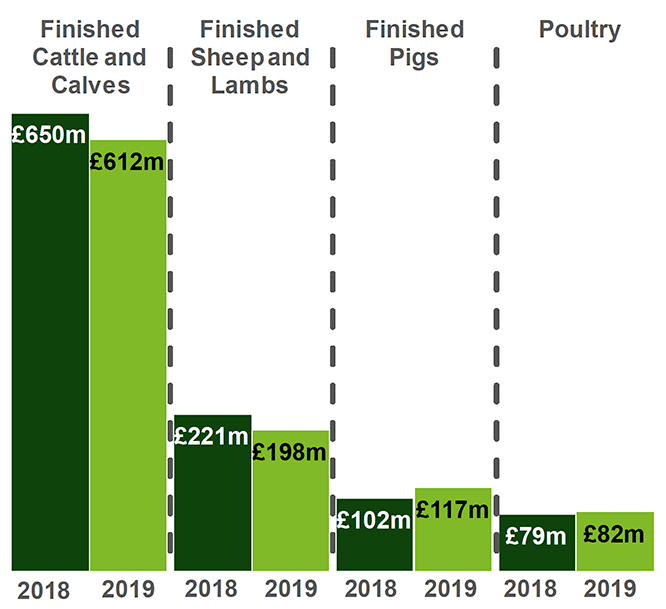
Chart Description
A column chart showing the value of cattle, sheep, pigs and poultry in 2018 and 2019. In 2018 finished cattle and calves value was £650 million and decreased to £612 million in 2019. Finished sheep and lambs value in 2018 was £221 million and decreased to £198 million in 2019. Finished pigs value in 2018 was £102 million and increased to £117 million in 2019. Poultry value in 2018 was £79 million and increased to £82 million in 2019. The value of finished cattle and calves is more than three times the value of the other livestock in 2019.
Total output from finished livestock in 2019: £1.04 billion
The value of finished cattle and calves decreased by £39 million in 2019. There was also a decrease in the value of finished sheep and lambs of £23 million.
These decreases are not unexpected as trade in the finished beef livestock markets was subdued across the UK. The sheep and lamb markets picked up in late 2019, but were below the 5 year average for most of the year.
Pigs and poultry, which are not eligible for direct support payments, experienced marginal gains in their output. Finished pigs rose by around £15 million pounds in 2019 and poultry by £3 million.
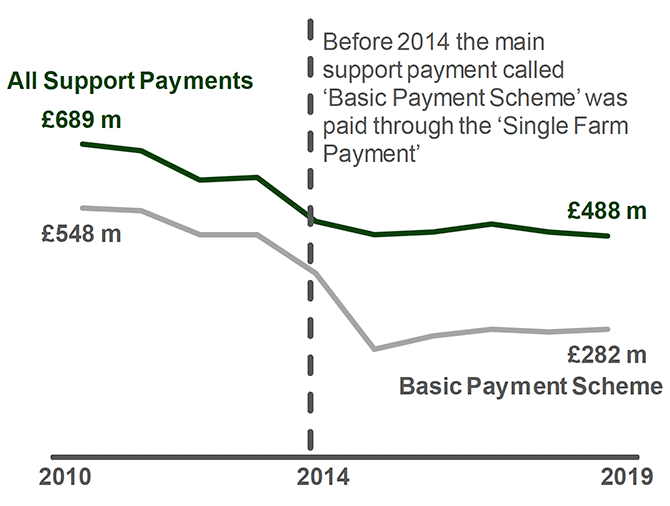
Chart Description
A line chart showing the value of support payments from 2010 to 2019. Support payments have steadily declined from £689 million in 2010 to £488 million in 2019. The majority of this support is through the Basic Payment Scheme. Before 2014 this was through the Single Farm Payment. Basic payments were £548 million in 2006 and £282 million in 2019.
All monetary values shown on this page are adjusted for inflation.
Total support payments to farming in 2019: £488 million
The value of support payments fell by 2% in real terms in 2019.
Basic Payments are estimated to have increased two per cent in 2019 to £282 million. This is due to the amount paid by the EU increasing, as the EU moves to make payments per hectare more equal throughout Europe.
The exchange rate can affect the overall amount of support available for agriculture. However in 2019 this had little effect on the overall payments received by Scottish Farmers as the exchange rate between sterling and the euro remained fairly constant over 2019.
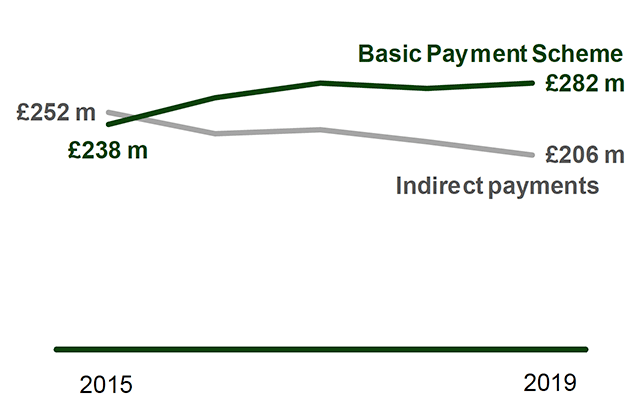
Chart Description
A line chart comparing the value of the Basic Payment Scheme and indirect payments from 2015 to 2019. The Basic Payment Scheme has increased and plateaued over this time from £238 million in 2015 to £282 million in 2019. Indirect payments have declined from £252 million in 2015 to £206 million in 2019.
All monetary values shown on this page are adjusted for inflation.
Total support payments to farming in 2019: £488 million
The Less Favoured Area Support Scheme (LFASS) payments fell to £52m in 2019. Other indirect support payments included £142 million in Greening payments and £4 million was made available to the Rural Priorities Scheme.
In total indirect payments decreased by 6 per cent in 2019
A further £40 million in support payments were made to support livestock production. Together these support payments accounted for 67 per cent of TIFF, which has remained consistent with previous year.Most support payments are made through the Basic Payment Scheme. This is a support payment made for farming activity. Other support schemes are made available for non-agricultural activity such as ‘Greening’ to help environmental sustainability or ‘LFASS’ which is a support payment paid to those farming in upland and remote areas where there are natural disadvantages.
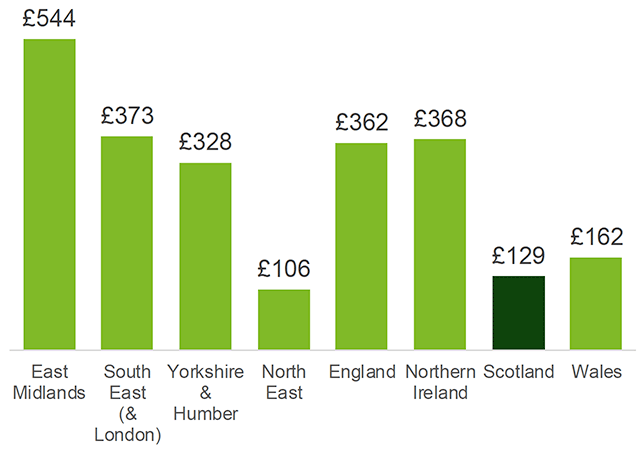
Chart Description
A column chart showing total income from farming per hectare for selected NUTS1 regions in the UK in 2018. East Midlands had the highest TIFF per hectare compared to the other regions, with a value of £544 per hectare. South East (and London) also had a large value for TIFF at £373 per hectare. Yorkshire and Humber had a similar TIFF, with £328 per hectare . North East has an income of £106 per hectare which is the lowest income for the UK. England’s average income per hectare is £362 and is comparable to Northern Irelands per hectare value of £368. Scotland’s per hectare income was £129 in 2018, comparable to the income of Wales at £162 per hectare.
Total Income from Farming per hectare, by NUTS1 region (selected regions), 2018
The UK is divided into 11 regions, including Scotland, Wales, Northern Ireland and eight English regions. These are referred to by the EU as NUTS1 areas.
Total income from farming per hectare in Scotland, 2018: £129 per hectare
Income in Scotland was similar, per hectare, to that in Wales and the least productive of England’s regions, North East England.
The region with the highest income, the East Midlands, generated £544 per hectare, over four times greater than Scotland.
The East Midlands region mainly produces high value crops and benefits from being closer to infrastructure and having a better climate and soil types that help sustain a wider variety of farming types.
Contact
Email: agric.stats@gov.scot
There is a problem
Thanks for your feedback